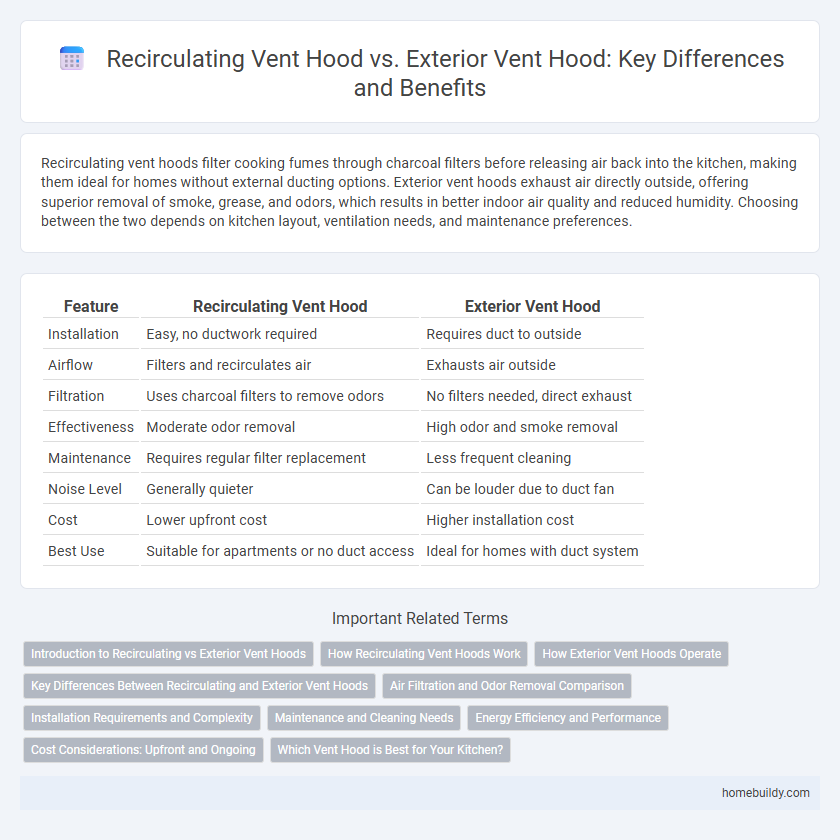Recirculating vent hoods filter cooking fumes through charcoal filters before releasing air back into the kitchen, making them ideal for homes without external ducting options. Exterior vent hoods exhaust air directly outside, offering superior removal of smoke, grease, and odors, which results in better indoor air quality and reduced humidity. Choosing between the two depends on kitchen layout, ventilation needs, and maintenance preferences.
Table of Comparison
| Feature | Recirculating Vent Hood | Exterior Vent Hood |
|---|---|---|
| Installation | Easy, no ductwork required | Requires duct to outside |
| Airflow | Filters and recirculates air | Exhausts air outside |
| Filtration | Uses charcoal filters to remove odors | No filters needed, direct exhaust |
| Effectiveness | Moderate odor removal | High odor and smoke removal |
| Maintenance | Requires regular filter replacement | Less frequent cleaning |
| Noise Level | Generally quieter | Can be louder due to duct fan |
| Cost | Lower upfront cost | Higher installation cost |
| Best Use | Suitable for apartments or no duct access | Ideal for homes with duct system |
Introduction to Recirculating vs Exterior Vent Hoods
Recirculating vent hoods filter and clean air by using charcoal filters before releasing it back into the kitchen, making them ideal for homes without exterior vent access. Exterior vent hoods expel smoke, odors, and moisture directly outside, providing more effective ventilation and improved indoor air quality. Choosing between the two depends on kitchen layout, venting options, and the level of air purification required.
How Recirculating Vent Hoods Work
Recirculating vent hoods draw cooking smoke and odors through filters that trap grease and neutralize smells before releasing clean air back into the kitchen. Unlike exterior vent hoods that vent pollutants outside, recirculating models rely on activated charcoal filters to absorb odors and are ideal for spaces without external ductwork. Their efficient filtration system requires periodic replacement of filters to maintain optimal air quality and performance.
How Exterior Vent Hoods Operate
Exterior vent hoods operate by channeling cooking fumes and airborne grease through ductwork that leads outside, ensuring effective removal of heat, smoke, and odors from the kitchen. They rely on powerful exhaust fans to pull contaminated air out, preventing moisture buildup and improving indoor air quality. Unlike recirculating vent hoods, exterior vent hoods maintain better ventilation by expelling pollutants directly outdoors rather than filtering and recirculating air back inside.
Key Differences Between Recirculating and Exterior Vent Hoods
Recirculating vent hoods filter cooking smoke and odors through charcoal and grease filters before releasing the cleansed air back into the kitchen, eliminating the need for external ductwork. Exterior vent hoods, also known as ducted hoods, exhaust air and contaminants directly outside through a vent system, providing superior air quality and moisture removal. Key differences include installation complexity, with recirculating hoods being easier to install but less effective at removing heat and humidity compared to exterior vent hoods.
Air Filtration and Odor Removal Comparison
Recirculating vent hoods use charcoal filters to trap grease and neutralize odors but recirculate air back into the kitchen, offering limited removal of heat and moisture. Exterior vent hoods expel air, smoke, and odors outside through ductwork, providing superior air filtration and odor elimination efficiency. The external venting system in exterior hoods ensures better indoor air quality by completely removing contaminants rather than trapping them internally.
Installation Requirements and Complexity
Recirculating vent hoods require minimal installation, as they do not need ductwork and simply filter and recirculate air back into the kitchen, making them ideal for apartments or spaces without external vent access. Exterior vent hoods demand more complex installation involving ductwork that vents cooking fumes outside, which requires cutting holes through walls or ceilings and ensuring proper airflow direction. The exterior vent hood installation is more time-consuming and costly but provides superior ventilation and air quality compared to recirculating models.
Maintenance and Cleaning Needs
Recirculating vent hoods require frequent filter cleaning or replacement, as they trap grease and odors internally without expelling air outside. Exterior vent hoods necessitate regular duct cleaning to prevent grease buildup and ensure efficient airflow through external venting systems. Both types demand routine maintenance, but exterior vent hoods typically involve more extensive cleaning of vent pipes and outdoor components.
Energy Efficiency and Performance
Recirculating vent hoods filter and recirculate indoor air using charcoal filters, consuming less energy by avoiding external venting but often offering lower airflow capacity and moisture removal compared to exterior vent hoods. Exterior vent hoods expel air outside, providing superior performance in removing heat, smoke, and odors while increasing energy use due to the demand on HVAC systems compensating for lost conditioned air. Choosing between the two impacts kitchen air quality and energy consumption, with exterior vent hoods favored for optimal ventilation despite higher operational costs.
Cost Considerations: Upfront and Ongoing
Recirculating vent hoods typically have lower upfront costs since they do not require ductwork or external vent installation, making them suitable for apartments or homes without exterior wall access. Exterior vent hoods involve higher initial expenses for duct installation and professional labor but offer more efficient smoke and odor removal, potentially reducing ongoing maintenance costs. Long-term energy consumption may be higher with recirculating models due to continuous fan operation and filter replacement, whereas exterior vent hoods generally have lower operational costs when properly maintained.
Which Vent Hood is Best for Your Kitchen?
Recirculating vent hoods filter cooking fumes through charcoal or mesh filters and release clean air back into the kitchen, ideal for homes without exterior venting options. Exterior vent hoods exhaust air outside, providing superior removal of smoke, odors, and grease while improving indoor air quality and reducing moisture buildup. Choosing the best vent hood depends on your kitchen layout, ventilation requirements, and local building codes, with exterior vent hoods preferred for optimal air purification in professional-grade or heavy-use kitchens.
Recirculating vent hood vs Exterior vent hood Infographic

 homebuildy.com
homebuildy.com